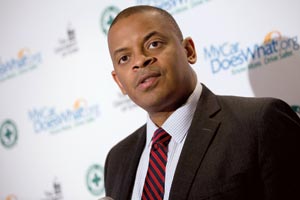Secretary Anthony Foxx Touts National Freight Strategic Plan, Gets Personal in TRB Address

Foxx said that the National Strategic Freight Plan can unlock “a system that’s multimodal, that has very distinct bottlenecks and gaps, and [lacks coherent] decision-making processes such as the fact that we basically have 52 different freight systems making it difficult [to see] how the system all works together.”
The National Freight Strategic Plan aims to encourage states to look beyond their boundaries to solve transportation problems and to think long term as part of a system that annually moves more than 55 million tons of goods worth nearly $50 billion.
Foxx said that even if DOT had gotten all of its wish list into the five-year highway bill that President Obama signed into law last month, the nation still would face the daunting challenge of moving 70 million more people and the goods they use over the next 30 years.
“We’re going to continue do the work of transforming our government for the 21st century … [with] innovation and technology that will improve people’s lives and connect them to opportunities,” Foxx said, continuing the president’s theme that the administration won’t stand down as it enters the final year of its tenure.
One way to do that will be via DOT’s Smart City Challenge announced last month, which Foxx said will produce “one winner but a lot of right answers.”
Foxx spent much of his address getting personal, harkening back to his roots in a Charlotte, North Carolina, neighborhood sandwiched between interstates 77 and 85. He criticized previous generations of transportation planners for separating poor, minority-dominated neighborhoods from the rest of their cities and helping to cause inequality and the loss in the belief in the American dream, what he called “structural discrimination."
"We should talk about taking people beyond their doorstep to opportunity, but we should also talk about bringing opportunity to their doorstep," Foxx said. "The lines we draw with infrastructure are somehow infused with the attitudes to bring the communities we affect. Transportation can help us solve the opportunity gap. We need to bring people together by design.”

